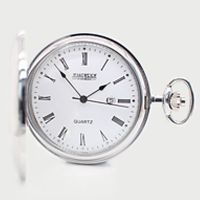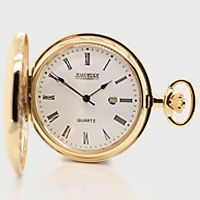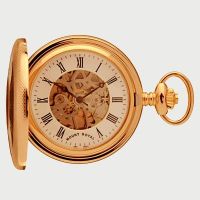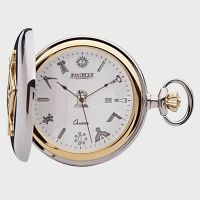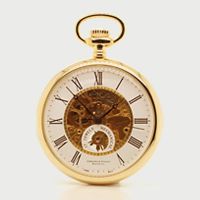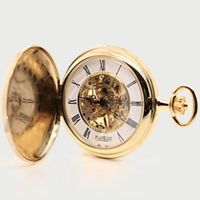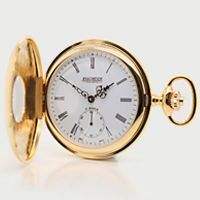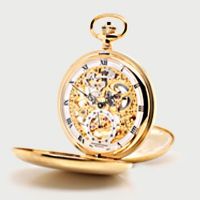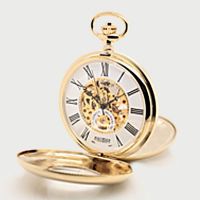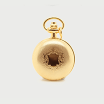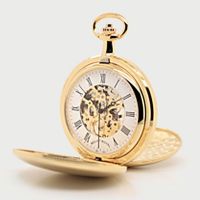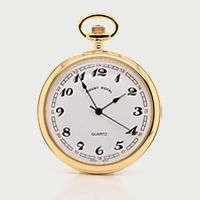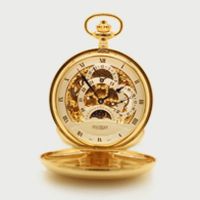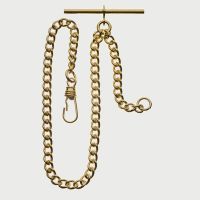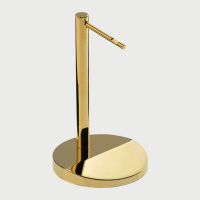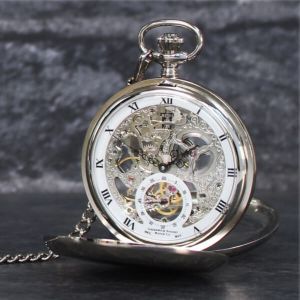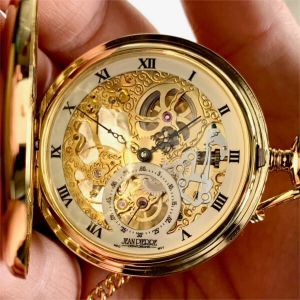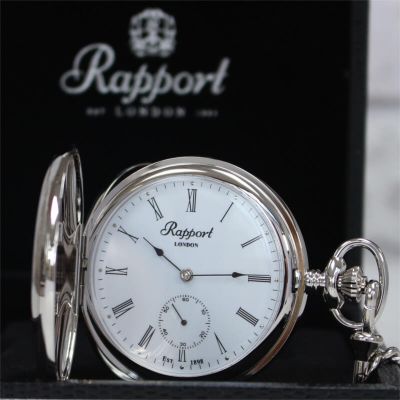Pocket Watch Terminology
ACRYLIC CRYSTAL
The inexpensive plastic crystal. It's not very hard and shallow scratches can be buffed out.
ALARM WATCH
A watch provided with a movement capable of releasing an acoustic sound at the time set. A second crown is dedicated to the winding, setting and release of the striking-work; an additional center hand indicates the time set. The section of the movement dedicated to the alarm device is made up by a series of wheels linked with the barrel, an escapement and a hammer striking a gong or bell. Works much like a normal alarm clock.
AMPLITUDE
Maximum angle by which a balance or pendulum wings from its rest position.
ANALOG or ANALOGUE
A watch displaying time indications by means of hands.
ANALOG QUARTZ
The most commonly-used term in referring to any analog timepiece that operates on a battery or on solar power and is regulated by a quartz crystal
ANNUAL CALENDAR, see calendar, annual
ANTIMAGNETIC
Said of a watch whose movement is not influenced by electromagnetic fields that could cause two or more windings of the balance-spring to stick to each other, consequently accelerating the rate of the watch. This effect is obtained by adopting metal alloys (e.g. Nivarox) resisting magnetization.
ANTIREFLECTION, ANTIREFLECTIVE
Superficial glass treatment assuring the dispersion of reflected light. Better results are obtained if both sides are treated, but in order to avoid scratches on the upper layer, the treatment of the inner surface is preferred.
ARBOR
Bearing element of a gear (s.) or balance, whose ends-called pivots - run in jewel holes or brass bushings.
ATMOSPHERE (ATM)
Unit of pressure used in watch making to indicate water-resistance
ATOMIC TIME STANDARD
Provided by the U.S. National Institute of Standards and Technology, Time and Frequency Division, Boulder, Colorado, atomic time is measured through vibrations of atoms in a metal isotope that resembles mercury. The result is extremely accurate time that can be measured on instruments. Radio waves transmit this exact time throughout North America and some "atomic" watches can receive them and correct to the exact time.
AUTOMATIC
A watch whose mechanical movement is wound automatically. A rotor makes short oscillations due to the movements of the wrist. Through a series of gears, oscillations transmit motion to the barrel, thus winding the mainspring progressively.
AUTOMATIC WINDING
A rotating weight, set into motion by moving the wrist, winds the going barrel via the gear train of a mechanical watch movement. Automatic winding was invented during the pocket watch era in 1770 by Abraham-louis Perrelet, who created a watch with a weight swinging to and fro (when carried in a vest pocket, a pocket watch usually makes vertical movements). The first automatic winding wristwatches, invented by John Harwood in the 1920s, utilized so-called hammer winding, whereby a weight swung in an arc between two banking pins. The breakthrough automatic winding movement via rotor began with the ball bearing Eterna-Matic in the late 1940s, and the workings of such a watch haven't changed fundamentally since. Today we speak of unidirectional winding and bi-directionally winding rotors, depending on the type of gear train used.
AUTOMATON
Figures, placed on the dial or case of watches, provided with parts of the body or other elements moving at the same time as the sonnerie strikes. The moving parts are linked, through an aperture on the dial or caseback, with the sonnerie hammers striking a gong.
BAGUETTE
Ladies style watch with a thin, elongated face; usually rectangular in shape but may be oval.
BALANCE
Oscillating device that, together with the balance spring, makes up the movement's heart in as much as its oscillations determine the frequency of its functioning and precision.
BALANCE SPRING
Component of the regulating unit that, together with the balance, determines the movement's precision. The material used is mostly a steel alloy (e.g. Nivarox, s.), an extremely stable metal compound. In order to prevent the system's center of gravity from continuous shifts, hence differences in rate due to the watch's position, some modifications were adopted. These modifications included Breguet's overcoil (closing the terminal part of the spring partly on itself, so as to assure an almost perfect centering) and Philips curve (helping to eliminate the lateral pressure of the balance-staff pivots against their bearings). Today, thanks to the quality of materials, it is possible to assure an excellent precision of movement working even with a flat spring.
BARREL
Component of the movement containing the mainspring, whose toothed rim meshes with the pinion of the first gear of the train. Due to the fact that the whole movement - made up of barrel and mainspring - transmits the motive force, it is also considered to be the very motor. Inside the barrel, the mainspring is wound around an arbor turned by the winding crown or, in the case of automatic movements, also by the gear powered by the rotor.
BASE METAL
Any non-precious metal.
BATTERY
Device that converts chemical energy into electricity. Most watch batteries are silver oxide type delivering 1.5 volts. Much longer-lasting lithium batteries are 3 volt.
BATTERY LIFE
The minimum period of time that a battery will continue to provide power to run the watch. Life begins at the point of manufacture when the factory initially installs the battery.
BATTERY RESERVE INDICATOR
Some battery-operated watches have a feature that indicates when the battery is approaching the end of its life. This is often indicated by the second hand moving in two second intervals instead of each second.
BEARING
Part on which a pivot turns, in watches it represented mostly by jewels.
BEVELING
Chamfering of edges of levers, bridges and other elements of a movement by 45░, a treatment typically found in high-grade movements.
BEZEL
Top part of case, often in a shape of the ring surrounding the watch face, sometimes holds the crystal. It may be integrated with the case middle or may be a separate element. It is snapped or screwed on to the middle.
BRACELET
A metal band attached to the case. It is called integral if there is no apparent discontinuity between case and bracelet and the profile of attachments is similar to the first link.
BRIDGE
Structural metal element of a movement - sometimes called cock or bar - supporting the wheel train, balance, escapement and barrel. Each bridge is fastened to the plate by means of screws and locked in a specific position by pins. In high-quality movements the sight surface is finished with various types of decoration.
BRUSHED, BRUSHING
Topical finishing giving metals a line finish, a clean and uniform look.
BUCKLE
Usually matching the case, it attaches the two parts of the leather strap around the wrist.
BUTTON
Push piece controls, usually at 2 o'clock and/or 4 o'clock on the dial to control special functions such as the chronograph or the alarm.
CABOCHON
Any kind of precious stone, such as sapphire, ruby or emerald, uncut and only polished, generally of a half-spherical shape, mainly used as an ornament of the winding crown or certain elements of the case.
CALENDAR, ANNUAL
An intermediate complication between a simple calendar and a perpetual calendar. This feature displays all the months with 30 or 31 days correctly, but needs a manual correction at the end of February. Generally, date, day of the week and month, or only day and month are displayed on the dial.
CALENDAR, FULL
Displaying date, day of the week and month on the dial, but needing a manual correction at the end of a month with less than 31 days. It is often combined with the moonphase.
CALENDAR, PERPETUAL
This is the most complex horology complication related to the calendar feature, as it indicates the date, day, month and leap year and does not need manual corrections until the year 2100 (when the leap year will be ignored).
CALIBER
Originally it indicated only the size of a movement, but now this indication defines a specific movement type and shape (e.g. round caliber) and combines it with the constructor's name and identification number. Therefore the caliber identifies the movement.
CANNON
An element in the shape of a hollow cylinder, sometimes also called pipe or bush, for instance the pipe of the hour wheel bearing the hour hand.
CARAT (KARAT)
Unit of gold fineness (and gemstone weight). Pure gold is 24k. 18k gold is 75% pure.
CAROUSEL
Device similar to the tourbillon, but with the carriage not driven by the fourth wheel, but by the third wheel.
CARRIAGE or TOURBILLON CARRIAGE
Rotating frame of a tourbillon device, carrying the balance and escapement. This structural element is essential for a perfect balance of the whole system and its stability, in spite of its reduced weight. As today's tourbillon carriages make a rotation per minute, errors of rate in the vertical position are eliminated. Because of the widespread use of transparent dials, carriages became elements of aesthetic attractiveness.
CASE
Container housing and protecting the movement, usually made up of three parts: middle, bezel, and back.
CENTER SECOND HAND, see sweep second hand.
CENTER-WHEEL
The minute wheel in a going-train.
CHAMPLEVÉ
Hand-made treatment of the dial or case surface. The pattern is obtained by hollowing a metal sheet with a graver and subsequently filling the hollows with enamel.
CHAPTER-RING
Hour-circle, i.e. the hour numerals arranged on a dial.
CHIME
Striking-work equipped with a set of bells that may be capable of playing a complete melody. A watch provided with such a feature is called chiming watch.
CHRONOGRAPH
A watch that includes a built-in stopwatch function, i.e. a timer that can be started and stopped to time an event. There are many variations of the chronograph.
CHRONOMETER
A high-precision watch. According to the Swiss law, a manufacture may put the word "chronometer" on a model only after each individual piece has passed a series of tests and obtained a running bulletin and a chronometer certificate by an acknowledged Swiss control authority, such as the COSC.
CIRCULAR GRAINING
Superficial decoration applied to bridges, rotors and pillar-plates in the shape of numerous slightly superposed small grains, obtained by using a plain cutter and abrasives. Also called Pearlage or Pearling.
CLASP
The attachment used to connect the two ends of the watch bracelet or strap around the wrist.
- Deployment Buckle - A three-folding enclosure, which secures the two ends of the bracelet and allows enough room for placing the watch on the wrist when fully deployed. When closed, the buckle covers the two-piece folding mechanism
- Hook Lock - Two separate units each fitting on either end of the bracelet which allows the watch to be laid out. One end of the closure hooks onto the other to secure the two ends of the bracelet.
- Jeweler's Clasp - A closure that is generally used on better bracelets. Also allows it to lie flat.
- Sliding Clasp - Also a hook type method but allows for easy sizing of the bracelet by sliding up.
- Twist Lock - A closure similar to Jeweler's Clasp used on ladies jewelry bracelets.
CLOISONNÉ
A kind of enamel work - mainly used for the decoration of dials - in which the outlines of the drawing are formed by thin metal wires. The colored enamel fills the hollows formed in this way. After oven firing, the surface is smoothed until the gold threads appear again.
CLOUS DE PARIS
Decoration of metal parts characterized by numerous small pyramids.
COCK, see bridge.
COLIMAÇONNAGE, see snailing.
COLUMN-WHEEL
Part of chronograph movements, governing the functions of various levers and parts of the chronograph operation, in the shape of a small-toothed steel cylinder. It is controlled by pushers through levers that hold and release it. It is a very precise and usually preferred type of chronograph operation.
COMPLICATION
Additional function with respect to the manual-winding basic movement for the display of hours, minutes and seconds. Today, certain features, such as automatic winding or date, are taken for granted, although they should be defined as complications. The main complications are moonphase, power reserve, GMT, and full calendar. Further functions are performed by the so-called great complications, such as split-second chronograph, perpetual calendar, tourbilon device, and minute repeater.
CORRECTOR
Pusher positioned on the case side that is normally actuated by a special tool for the quick setting of different indications, such as date, GMT, full or perpetual calendar.
COSC
Abbreviation of "Contrôle Officiel Suisse des Chronomètres" the most important Swiss institution responsible for the functioning and precision tests of movements of chronometers. Tests are performed on each individual watch at different temperatures and in different positions before a functioning bulletin and a chronometer certificate are issued, for which a maximum gap of -4..+4 seconds per day is tolerated.
CÔTES CIRCULAIRES
Decoration of rotors and bridges of movements, whose pattern consists of a series of concentric ribs.
CÔTES DE GENÈVE
Decoration applied mainly to high-quality movements, appearing as a series of parallel ribs, realized by repeated cuts of a cutter leaving thin stripes.
COUNTDOWN TIMER
A function that lets the wearer keep track of how much of a pre-set period of time has elapsed. Some countdown timers sound a warning signal a few seconds before the time runs out. These are useful in events such all kinds of race.
COUNTER
Additional hand on a chronograph, indicating the time elapsed since the beginning of the measuring. On modern watches the second counter is placed at the center, while minute and hour counters have off-center hands in special zones, also called subdials.
CROWN
Usually positioned on the case middle and allows winding, hand setting and often date or GMT hand setting. As it is linked to the movement through the winding stem passing through a hole in the case. For waterproofing purposes, simple gaskets are used in water-resistant watches, while diving watches adopt screwing systems (screw-down crowns).
CROWN WHEEL
Wheel meshing with the winding pinion and with the ratchet wheel on the barrel-arbor.
CRYSTAL
The clean cover over the watch face. Three types of crystals are commonly found in watches: acrylic crystal, mineral crystal and sapphire crystal .
DEPTH ALARM
An alarm on a divers' watch that sounds when the wearer exceeds a pre-set depth.
DEPTH METER or DEPTH SENSOR
A device on a divers' watch that determines the wearer's depth by measuring water pressure. It shows the depth either by analog hands and a scale on the watch face or through a digital display.
DECK WATCH
A large-sized ship's chronometer.
DEVIATION
A progressive natural change of a watch's rate with respect to objective time. In case of a watch's faster rate, the deviation is defined positive, in the opposite case negative.
DIAL
Face of a watch, on which time and further functions are displayed by markers, hands, discs or through windows. Normally it is made of a brass - sometimes silver or gold.
DIGITAL WATCH
Said of watches whose indications are displayed mostly inside an aperture or window on the dial.
DIVERS' WATCH
A watch that is water resistant to 200M. Has a unidirectional rotating bezel and a screw-on crown and back. Has a metal or rubber strap (not leather). May have a sapphire crystal and possibly, a wet-suit extension.
EBAUCHE
Incomplete (jeweled or non-jeweled) watch movement without regulating organs, mainspring, dial and hands.
ECO-DRIVE
A name for a patented power mechanism found on some Citizen watches. This mechanism uses ordinary light to keep a rechargeable battery powered for watch operation. This technology is very sophisticated allowing some watch models to remain powered for up to 5 years in the dark. Watches with Eco-Drive technology will never need to have the battery replaced.
ELAPSED TIME ROTATING BEZEL
A graduated rotating bezel used to keep track of elapsed time. The bezel can be turned so the wearer can align the zero on the bezel with the watch's seconds or minutes hand. After a period of time passes, you can read the elapsed time off the bezel. This saves you having to perform the subtraction that would be necessary if you used the watch's regular dial.
ELECTROPLATING PROCESS
Process of covering metal articles with a film of other metals. The article is immersed in a chemical solution; electric current (D.C.) flows through the solution from a piece of metal (anode) to the article (cathode), depositing metal thereon by electrolysis.
ENDSTONE
Undrilled jewel, placed on the balance jewel with the tip of the balance-staff pivot resting against its flat surface, to reduce pivot friction. Sometimes used also for pallet staffs and escape wheels.
ENGINE-TURNED, see guilloché.
EQUATION OF TIME
Indication of the difference, expressed in minutes, between conventional mean time and real solar time. This difference varies from -16 to +16 seconds between one day and the other.
EQUINOX
The time when day and night are of equal length, when the sun is on the plane of the equator. Such times occur twice in a year: the vernal equinox on March 21st-22nd and the autumnal equinox on September 22nd-23rd.
ESCAPEMENT
Positioned between the train and the balance wheel and governing the rotation speed of the wheel - train wheels. In today's horology the most widespread escapement type is the lever escapement. In the past, numerous types of escapements were realized, such as: verge, cylinder, pin-pallet, detent and duplex escapements. Recently, George Daniels developed a so-called "coaxial" escapement.
ESCAPE WHEEL
A wheel belonging to the mechanism called escapement
FLANGE
The usually inclined ring that separates the crystal from the dial. The flange is sometimes equipped with features such as tachymetric scales and pulsometers.
FLINQUÉ
Engraving on the dial or case of a watch, covered with an enamel layer.
FLUTED
Said of surfaces worked with thin parallel grooves, mostly on dials or case bezels.
FLY-BACK
Feature combined with chronograph functions, that allows a new measurement starting from zero (and interrupting a measuring already under way) by pressing down a single pusher, i.e. without stopping, zeroing and restarting the whole mechanism. Originally, this function was developed to meet the needs of air forces.
FOLD-OVER CLASP
Hinged and jointed element, normally of the same material as the one used for the case. It allows easy fastening of the bracelet on the wrist. Often provided with a snap-in locking device, sometimes with an additional clip or push-piece.
FOURTH WHEEL
The seconds wheel in going-train.
FREQUENCY, see also vibration
Generally defined as the number of cycles per time unit; in horology it is the number of oscillations of a balance every two seconds or of its vibrations per second. For practical purposes, frequency is expressed in vibrations per hour (vph).
FUSEE
A conical part with a spiral groove on which a chain or cord attached to the barrel is wound. Its purpose is to equalize the driving power transmitted to the train.
GENEVA SEAL, see poinçon de Geneve.
GLASS, see also crystal
Thin plate of glass or transparent synthetic material, for protecting the dial of the watch.
GLUCYDUR
Bronze and beryllium alloy used for high-quality balances. This alloy assures high elasticity and hardness values; it is non-magnetic, rustproof and has a very reduced dilatation coefficient, which makes the balance very stable and assures high accuracy of the movement.
GMT
Abbreviation for Greenwich Mean Time. As a feature of watches, it means that two or more time zones are displayed. In this case, the second time may be read from a hand making a full rotation in a 24-hour ring (thereby also indicating whether it is a.m. or p.m. in that zone).
GONG
Harmonic flattened bell in a steel alloy, generally positioned along the circumference of the movement and struck by hammers to indicate time by sounds. Size and thickness determine the resulting note and tone. In watches provided with minute-repeaters, there are often two gongs and the hammers strike one note to indicate hours, both notes together to indicate quarters and the other note for the remaining minutes. In more complex models, equipped also with en-passant sonnerie devices, there may be up to four gongs producing different notes and playing even simple melodies (such as the chime of London's Big Ben).
GUILLOCHE
Decoration of dials, rotors or case parts consisting of patterns made by hand or engine-turned. By the thin pattern of the resulting engravings - consisting of crossing or interlaced lines - it is possible to realize even complex drawings. Dials and rotors decorated in this way are generally in gold or in solid silver.
HAMMER
Steel or brass element used in movements provided with a repeater or alarm sonnerie. It strikes a gong or bell (s).
HAND
Indicator for the analogue visualization of hours, minutes and seconds as well as other functions. Normally made of brass (rhodium-plated, gilded or treated otherwise), but also steel or gold. Hands are available in different shapes and take part in the aesthetic result of the whole watch.
HARDLEX CRYSTAL
is Seiko's trademarked name for a hardened mineral crystal.
HEART-PIECE
Heart-shaped corn, generally used to realign the hands of chronograph counters.
HELIUM VALVE
Valve inserted in the case of some professional diving watches to discharge the helium contained in the air mixture inhaled by divers.
HEXALITE
An artificial glass made of a plastic resin. Back in the 1960's, many watches used either mineral glass or acrylic crystals. These are not difficult to scratch, but very inexpensive to replace. Now though, most all luxury watches use the highly scratch resistant synthetic sapphire crystals, there are some styles/brands that use the Hesalite (a name brand of fine acrylic crystal). The reason for this is directly related to the watch's certification for use in space or in high stress/impact situations. While sapphire crystals are less prone to scratching, they can be shattered. When shattered, they break into tiny fragments that would be hazardous in some environments. So the Hesalite crystal is maintained on some specific models as a safety feature.
HUNTER CALIBER
A caliber characterized by the seconds hand fitted on an axis perpendicular to the one of the winding stem.
INCABLOC, see shockproof.
JEWEL
Precious stone used in movements as a bearing surface. Generally speaking, the steel pivots of wheels in movements turn inside synthetic jewels (mostly rubies) lubricated with a drop of oil. The jewel's hardness reduces wear to a minimum even over long periods of time (50 to 100 years). The quality of watches is determined mainly by the shape and finishing of jewels rather than by their number (the most refined jewels have rounded holes and walls to greatly reduce the contact between pivot and stone).
JUMPING HOUR
Feature concerning the digital display of time in a window. The indication changes almost instantaneously at every hour.
KINETIC
Refers to the Seiko line of Kinetic watches. This innovative technology has a quartz movement that does not use a battery. Movement of the wrist charges a very efficient capacitor which powers the quartz movement. Once the capacitor is fully charged, men's models will store energy for 7-14 days without being worn. Ladies models store energy for 3-7 days. Of course, if the watch is worn every day the capacitor is continually recharged. The watch alerts the owner to a low capacitor charge when the seconds hand starts to move in two second intervals. Some of Seiko's Kinetic Watches have See-Thru CaseBacks, that use a clear, Hardlex crystal watch back to enable the wearer to view the kinetic movement.
KINETIC AUTO RELAY
A Seiko Kinetic Auto Relay watch is powered by human movement, however when it senses inactivity for three days, it puts itself into suspended animation to conserve energy. It can be re-activated with a few shakes of the wrist. It automatically resets itself to the exact time after to up to four years of dormancy.
LAP TIMER
A chronograph function that lets the wearer time segments of a race. At the end of a lap, he stops the timer, which then returns to zero to begin timing the next lap.
LEAP-YEAR CYCLE
Leap or bissextile years have 366 days and occur every 4 years (with some exceptions, Calendar, Gregorian). Some watches display this datum.
LEPINE CALIBER
A caliber typical for pocket-watches, characterized by the seconds hand fitted in the axis of the winding-stem.
LINE
Ancient French measuring unit maintained in horology to indicate the diameter of a movement. A line equals 2.255mm. Lines are not divided into decimals; therefore, to indicate measures inferior to the unit, fractions are used.
LIQUID CRYSTAL DISPLAY or LCD
A digital watch display that shows the time electronically by means of a liquid held in a thin layer between two transparent plates. All LCD watches have quartz movements.
LUBRICATION
To reduce friction caused by the running of wheels and other parts. There are points to be lubricated with specific low-density oils such as the pivots turning inside jewels, the sliding areas between levers, and the spring inside the barrel (requiring a special grease), as well as numerous other parts of a movement.
LUG
Double extension of the case middle by which a strap or bracelet is attached. Normally, straps and bracelets are attached with removable spring bars.
LUMINESCENT or LUMINOUS
Said of materials applied on markers and/or hands, emitting the luminous energy previously absorbed as electromagnetic light rays. Tritium is no longer used and was replaced by other substances having the same emitting powers, but with virtually zero radioactivity, such as Super-LumiNova and Lumibrite.
MAINSPRING
This and the barrel make up the driving element of a movement. It stores and transmits the power force needed for its functioning.
MANUAL
A mechanical movement in which winding is performed by hand. The motion transmitted from the user's fingers to the crown is forwarded to the movement through the winding stem, from this to the barrel through a series of gears and finally to the mainspring.
MARINE CHRONOMETER
A large-sized chronometer watch enclosed in a box (therefore also called box chronometer) mounted on gimbals and used, on board of ships, to determine the respective longitude.
MARKERS
Elements printed or applied on the dial, sometimes they are luminescent, used as reference points for the hands to indicate hours and fifteen- or five-minute intervals.
MEANTIME
The mean time of the meridian of the Greenwich Observatory, considered the universal meridian, is used as a standard of the civil time system, counted from midnight to midnight.
MEASUREMENT CONVERSION
A feature, usually consisting of a graduated scale on the watch's bezel, that lets the wearer translate one type of measurement into another - miles into kilometers, for instance, or pounds into kilograms.
MECHANICAL MOVEMENT
A movement powered by a mainspring, working in conjunction with a balance wheel. Most watches today have electronically controlled quartz movements and are powered by a battery. However, mechanical watches are currently enjoying a resurgence in popularity.
MICROMETER SCREW
Element positioned on the regulator, allowing to shift it by minimal and perfectly gauged ranges so as to obtain accurate regulations of the movement.
MICRO-ROTOR, see rotor.
MILITARY TIME or 24-HOUR TIME
When time is measured in 24-hour segments. To convert 12-hour time into 24-hour time, simply add 12 to any p.m. time. To convert 24-hour time into 12-hour time, subtract 12 from any time from 13 to 24.
MINERAL CRYSTAL or MINERAL GLASS
Watch crystal that has been tempered (heat treated) to increase its hardness and scratch resistance.
MINUTE REPEATER, see repeater.
MODULE
Self-contained mechanism, independent of the basic caliber, added to the movement to make an additional function available: chronograph, power reserve, GMT, perpetual or full calendar (s).
MOONPHASE
A function available in many watches, usually combined with calendar-related features. The moonphase disc advances one tooth every 24 hours. Normally, this wheel has 59 teeth and assures an almost perfect synchronization with the lunation period, i.e. 29.53 days (in fact, the disc shows the moonphases twice during a single revolution). However, the difference of 0.03 days, i.e. 44 minutes each month, implies the need for a manual adjustment every two and a half years to recover one day lost with respect to the real state of moonphase. In some rare case, the transmission ratio between the gears controlling the moonphase are calculated with extreme accuracy so as to require manual correction only once in 100 years.
MOTHER OF PEARL
Iridescent, milky interior shell of the fresh water mollusk that is sliced thin and used on watch dials. While most have a milky white luster, mother-of-pearl also comes in other colors such as silvery gray, gray blue, pink, and salmon.
MOVEMENT
The entire mechanism of a watch. Movements are divided into two great families: quartz and mechanical; the latter are available with manual or automatic winding devices.
NIVAROX
Trade name (from the producer's name) of a steel alloy, resisting magnetization, used for modern self-compensating balance springs. The quality level of this material is indicated by the numeral following the name in decreasing value from 1 to 5.
OBSERVATORY CHRONOMETER
An observatory-tested precision watch that obtained the relevant rating chronometer certificate.
OSCILLATION
Complete oscillation or rotation movement of the balance, formed by two vibrations.
PALLETS
Device of the escapement transmitting part of the motive force to the balance, in order to maintain the amplitude of oscillations unchanged by freeing a tooth of the escape wheel at one time.
PERPETUAL CALENDAR see calendar, perpetual
PILLAR-PLATE or MAIN PLATE
Supporting element of bridges and other parts of a movement.
PINION
Combines with a wheel and an arbor to form a gear. A pinion has less teeth than a wheel and transmits motive force to a wheel. Pinion teeth (normally 6 to 14) are highly polished to reduce friction to a minimum.
PIVOT
End of an arbor turning on a jewel support. As their shape and size can influence friction, the pivots of the balance-staff are particularly thin and, hence, fragile, so they are protected by a shockproof system.
PLATED
Metal, treated by a galvanizing procedure in order to apply a slight layer of gold or another precious metal (silver, chromium, rhodium or palladium) on a brass or steel base.
PLEXIGLAS
A synthetic resin used for watch crystal.
POINÇON DE GENEVE
Distinction assigned by the Canton of Geneva to movements produced by watchmaker firms of the Region and complying with all the standards of high horology with respect to craftsmanship, small-scale production, working quality, accurate assembly and setting. The Geneva Seal is engraved on at least one bridge and shows the Canton's symbol, i.e. a two-field shield with an eagle and a key respectively in each field.
POLISHED FINISH
Brilliant metal surface obtained on the watch case with fine abrasive. Compare to brushed finish.
POWER RESERVE
Duration (in hours) of the residual functioning autonomy of a movement after it has reached the winding peak. The duration value is displayed by an instantaneous indicator: analog (hand on a sector) or digital (through a window). The related mechanism is made up of a series of gears linking the winding barrel and hand. Recently, specific modules were introduced which may be combined with the most popular movements.
PRECISION
Accuracy rate of a watch, a term difficult to define exactly. Usually, a precision watch is a chronometer whose accuracy-standard is certified by an official watch-rating bureau.
PULSIMETER CHRONOGRAPH
The pulsimeter scale shows, at a glance, the number of pulse beats per minute. The observer releases the chronograph hand when starting to count the beats and stops at the 30th, the 20th or the 15th beat according to the basis of calibration indicated on the dial.
PUSHER, PUSH-PIECE or PUSH-BUTTON
Mechanical element mounted on a case for the control of specific functions. Generally, pushers are used in chronographs, but also with other functions.
PVD
Abbreviation of Physical Vapor Deposition, a plating process consisting of the physical transfer of substance by bombardment of electrons.
QUARTZ
The quartz movement uses the famously stable vibration frequency of a quartz crystal subjected to electronic tension (usually 32,868 Hz) as its norm. The fact that a quartz-controlled second hand jumps to the tact of each second is a concession to the use of outside energy. This technical revolution found its way to the world's wrists in the late 1960s. This was a principally Swiss invention - the first working quartz wristwatches were manufactured by Girard-Perregaux and Piaget as the result of an early joint venture within the Swiss watch industry, but the Japanese (primarily Seiko) came to dominate the market with new technology.
QUARTZ MOVEMENT
A movement powered by a quartz crystal. Quartz crystals are very accurate. They can be mass produced which makes them less expensive than most mechanical movements which require a higher degree craftsmanship.
RATCHET WHEEL
Toothed wheel prevented from moving by a click pressed down by a spring.
REGULATING UNIT
Made up by balance and balance spring, governing the division of time within the mechanical movement, assuring its regular running and accuracy. As the balance works like a pendulum, the balance spring's function consists of its elastic return and starting of a new oscillation. This combined action determines the frequency, i.e. the number of vibrations per hour, and affects the rotation speed of the different wheels. In fact the balance, by its oscillations, at every vibration (through the action of the pallets), frees a tooth of the escape wheel (see escapement). From this, motion is transmitted to the fourth wheel, which makes a revolution in one minute, to the third and then the center wheel, the latter making a full rotation in one hour. However, everything is determined by the correct time interval of the oscillations of the balance.
REGULATOR
Regulating the functioning of a movement by lengthening and shortening the active section of the balance spring. It is positioned on the balance-bridge and encompasses the balance spring with its two pins near its fixing point on the bridge itself. By shifting the index, the pins also are moved and, by consequence, the portion of the balance spring capable of bringing the balance back is lengthened or shortened by its elastic force. The shorter it is, the more reactive it tends to be and the more rapidly it brings the balance back and makes the movement run faster. The contrary happens when the active portion of the balance spring is lengthened. Given today's high frequencies of functioning, even slight index shifts entail daily variations of minutes. Recently, even more refined index-regulation systems were adopted (from eccentric to micrometer screws) to limit error margins to very few seconds per day.
REMONTOIR or CONSTANT-FORCE
Old term used to denote any mechanism assuring a constant transmission of the driving power to the escape wheel.
REPEATER
Mechanism indicating time by acoustic sounds. Contrary to the watches provided with en-passant sonnerie devices, that strike the number of hours automatically, repeaters work on demand by actuating a slide or pusher positioned on the case side. Repeaters are normally provided with two hammers and two gongs: one gong for the minutes and one for the hours. The quarters are obtained by the almost simultaneous strike of both hammers. The mechanism of the striking work is among the most complex complications.
RETROGRADE
Said of a hand that, instead of making a revolution of 360░ before starting a new measurement, moves on an arc scale (generally of 90░ to 180░ and at the end of its trip comes back instantaneously. Normally, retrograde hands are used to indicate date, day or month in perpetual calendars, but there are also cases of retrograde hours, minutes or seconds. Unlike the case of the classical indication over 360░ the retrograde system requires a special mechanism to be inserted into the basic movement.
ROLLER TABLE or ROLLER
Part of the escapement in the shape of a disc fitted to the balance staff and carrying the impulse pin that transmits the impulses given by the pallets to the balance.
ROTATING BEZEL
A bezel that can be turned. Different types of rotating bezels perform different time keeping and mathematical functions.
ROTOR
In automatic-winding mechanical movements the rotor is the part that, by its complete or partial revolutions and the movements of human arm, allows winding of the mainspring.
SAPPHIRE CRYSTAL
Synthetic corundum crystal with a hardness second only to diamond. Transparent sapphire is the most expensive and durable and used for scratch-proof watch glasses. A non-reflective coating on some sport styles prevents glare
SAPPHLEX CRYSTAL
Seiko's trademarked name for a fusion of sapphire and mineral glass crystals
SCALE
Graduation on a measuring instrument, showing the divisions of a whole of values, especially on a dial, bezel. The scales mostly used in horology are related to the following measuring devices: tachometer (indicating the average speed), telemeter (indicating the distance of a simultaneously luminous and acoustic source, e.g. a cannon-shot or a thunder and related lightning), pulsometer (to calculate the total number of heartbeats per minute by counting only a certain quantity of them). For all of these scales, measuring starts at the beginning of the event concerned and stops at its end; the reading refers directly to the chronograph second hand, without requiring further calculations.
SCREW BALANCE
Before the invention of the perfectly weighted balance by use of a smooth ring, balances were fitted with weighted screws to get the exact impetus desired. Today a screw balance is a subtle sign of quality in a movement due to its costly construction.
SCREW-DOWN LOCKING CROWN
A crown which aids water resistance by sealing the crown against the case. The seal is achieved by the matching of a threaded pipe on the case with the crown's internal threads and gasketing while twisting the crown to lock it into place.
SECOND TIME-ZONE INDICATOR
An additional dial that can be set to the time in another time zone. It lets the wearer keep track of local time and the time in another country simultaneously. See also GMT and world time.
SECTOR, see rotor.
SELF-WINDING, see automatic.
SHOCKPROOF or SHOCK-RESISTANT
Watches provided with shock-absorber systems (e.g. Incabloc) help prevent damage from shocks to the balance pivots. Thanks to a retaining spring system, it assures an elastic play of both jewels, thus absorbing the movements of the balance-staff pivots when the watch receives strong shocks. The return to the previous position is due to the return effect of the spring. If such a system is lacking, the shock forces exert an impact on the balance-staff pivots, often causing bending or even breakage.
SIDEREAL TIME
The conventional time standard refers to the sidereal year (defined in terms of an average of 365.25636 days) considered to be perfectly regular until very recently, but - even though this is not true - the difference is so slight that it is virtually neglected. As a unit of time, the sidereal day is used mainly by astronomers to define the interval between two upper transits of the vernal point in the plane of the meridian.
SKELETON, SKELETONIZED
Watches whose bridges and pillar-plates are cut out in a decorative manner, thus revealing all the parts of the movement.
SLIDE
Part of a mechanism moving with friction on a slide-bar or guide.
SMALL SECOND
Time display in which the second hand is placed in a small subdial.
SNAILING
Decoration with a spiral pattern, mainly used on the barrel wheel or on big-sized full wheels.
SOLAR POWERED
A watch that uses solar energy (from any light source) to power the quartz movement. Citizen call their solar powered watches "Eco-Drive".
SOLAR TIME
The time standard referred to the relative motion of the Earth and the Sun governing the length of day and night. The true solar day is the period measured after the Sun appears again in the same position from our point of observation. Due to the non-uniform rotation of the Earth around the Sun, this measure is not regular. As an invariable measure unit, the mean solar day corresponds to the average duration of all the days of the year.
SOLSTICE
The time when the sun is farthest from the equator, i.e. on June 21st (Summer solstice) and December 21st (Winter solstice).
SONNERIE (EN PASSANT)
Function consisting of an acoustic sound, obtained by a striking work made up of two hammers striking gongs (s.) at set hours, quarter- and half-hours. Some devices can emit a chime (with three or even four hammers and gongs). By a slide or an additional pusher it is possible to exclude the sonnerie device and to select a so-called grande sonnerie.
SPLIT-SECOND CHRONOGRAPH
Chronographs with split-second mechanisms are particularly useful for timing simultaneous phenomena which begin at the same time, but end at different times, such as sporting events in which several competitors are taking part. In chronographs of this type, an additional hand is superimposed on the chronograph hand. Pressure on the pusher starts both hands, which remain superimposed as long as the split-second mechanism is not blocked. This is achieved when the split-second hand is stopped while the chronograph hand continues to move. After recording, the same pusher is pressed a second time, releasing the split-second hand, which instantly joins the still-moving chronograph hand, synchronizing with it, and is thus ready for another recording. Pressure on the return pusher brings the hands back to zero simultaneously, provided the split-second hand is not blocked. Pressure on the split pusher releases the split-second hand, which instantly joins the chronograph hand if the split-second hand happens to be blocked.
STAFF or STEM, see arbor.
STOPWATCH
A watch with a seconds hand that measures intervals of time. When a stopwatch is incorporated into a standard watch, both the stopwatch function and the timepiece are referred to as a chronograph.
STOPWORK
Traditional device (now obsolete) provided with a finger piece fixed to the barrel arbor and a small wheel in the shape of a Maltese cross mounted on the barrel cover, limiting the extent to which the barrel can be wound.
STRIKING WORK, see sonnerie and repeater.
SUBDIAL, see also zone.
A small dial on a watch face used for any of several purposes, such as keeping track of elapsed minutes or hours on a chronograph or indicating the date.
SUPER-LUMINOVA, see luminescent.
SWEEP SECOND HAND
A center second hand, i.e. a second hand mounted on the center of the main dial.
TACHOMETER or TACHYMETER
Function measuring the speed at which the wearer runs over a given distance. The tachometer scale is calibrated to show the speed of a moving object, such as a vehicle, over a known distance. The standard length on which the calibration is based is always shown on the dial, e.g. 1,000, 200 or 100 meters, or-in some cases-one mile. As the moving vehicle, for instance, passes the starting point of the measured course whose length corresponds to that used as the basis of calibration, the observer releases the chronograph hand and stops it as the vehicle passes the finishing point. The figure indicated by the hand on the tachometer scale represents the speed in kilometers or miles per hour.
A scale on the dial, flange, or bezel of a chronograph that, in conjunction with the second hand, gives the speed of a moving object. A tachymeter takes a value determined in less than a minute and converts it into miles per hour. For example, a wearer could measure the time it takes a car to pass between two mile markers on the highway. When the car passes the second marker, the second hand will be pointing to the car's speed in miles per hour on the tachymetric scale.
TANK WATCH
A rectangular watch designed by Louis Cartier. The bars along the sides of the watch were inspired by the tracks of tanks used in World War I.
TELEMETER
Telemeter scale allows to measure the distance of a phenomenon that is both visible and audible. The chronograph hand is released at the instant the phenomenon is seen; it is stopped when the sound is heard, and its position on the scale shows, at a glance, the distance in kilometers or miles separating the phenomenon from the observer. Calibration is based upon the speed at which sound travels through the air (approx. 340 meters or 1115 feet per second). During a thunderstorm, the time that has elapsed between the flash of lightning and the sound of the thunder is registered on the chronograph scale.
THIRD WHEEL
Wheel positioned between the minutes and seconds wheels.
TIMER
Instrument used for registering intervals of time (duration, brief times), without any indication of the time of day.
TIME ZONES
The 24 equal spherical zones unto which the surface of the Earth is conventionally divided, each limited by two meridians. The distance between two adjacent zones is 15░ or 1 hour. Each country adopts. the time of its zone, except for countries with more than one zone. The universal standard time is that of the zero zone whose axis is the Greenwich meridian.
TITANIUM
Titanium is an environmentally friendly, natural metal that is 40% stronger and 30% lighter than stainless steel. It is hypoallergenic because it is nickel-free. It is perfect for water sport enthusiasts as it is extremely resistant to salt water and other forms of corrosion and able to withstand extreme temperatures. Many titanium watches are further enhanced with a glass coating for increased scratch resistance.
TONNEAU
Particular shape of a watchcase, imitating the profile of a barrel, i.e. with straight, shorter, horizontal sides and curved, longer, vertical sides.
TOURBILLON
Device invented in 1801 by A. L. Breguet. This function equalizes position errors due to changing positions of a watch and related effects of gravity. Balance, balance spring and escapement are housed inside a carriage, also called a cage, rotating by one revolution per minute, thus compensating for all the possible errors over 360░. In a tourbillon (from the French word for whirl), the entire escapement is mounted on an epicyclic train in a "cage" and rotated completely on its axis over regular periods of time, usually once a minute. Although this device is not absolutely necessary for accuracy purposes today, it is still appreciated as a complication of high-quality watches.
TRAIN
All the wheels between barrel and escapement.
TRITIUM
Slightly radioactive material that collects light energy and is used to coat hands, numerals, and hour markers on watch dials in order to make reading the time in the dark possible. Watches bearing tritium must be marked as such, with the letter T on the dial near 6 o'clock. It is gradually being replaced by nonradioactive materials such as Superluminova and Traser due to medical misgivings and expected governmental regulation of its use.
TWO-TONE
A term use to indicate that a watch has both "silver" and "gold" tone color which may or may not be genuine gold or silver.
UNIDIRECTIONAL ROTATING BEZEL
An elapsed time rotating bezel, often found on divers' watches, that moves only in a counterclockwise direction. It is designed to prevent a diver who has unwittingly knocked the bezel off its original position from overestimating his remaining air supply. Because the bezel moves in only one direction, the diver can err only on the side of safety when timing his dive. Many divers' watches are ratcheted, so that they lock into place for greater safety.
UNIVERSAL TIME
The mean solar time of the Greenwich meridian, counted from noon to noon, Often confused with the mean time notion.
VARIATION
In horology the term is usually referred to the variation of the daily rate, i.e. the difference between two daily rates specified by a time interval.
VIBRATION
Movement of a pendulum or other oscillating bodies, limited by two consecutive extreme positions. In an alternate (pendulum or balance) movement, a vibration is a half of an oscillation. The number of hourly vibrations corresponds to the frequency of a watch movement, determined by the mass and diameter of a balance and the elastic force of the balance spring. The number of vibrations per hour (vph) determines the breaking up of time (the "steps of a second hand). For instance, 18,000 vph equals a vibration duration of 1/5 second; in the same way 21,600 vph = 1/6 second; 28,800 vph = 1/8 second; 36,000 vph = 1/10 second. Until the 1950s, wristwatches worked mostly at a frequency of 18,000 vph; later, higher frequencies were adopted to produce a lower percentage of irregularities to the rate. Today, the most common frequency adopted is 28,800 vph, which assures a good precision standard and less lubrication problems than extremely high frequencies, such as 36,000 vph.
WATER RESISTANT or WATERPROOF
A watch whose case is designed in such a way as to resist infiltration by water (3 ATM, or atmospheres, corresponding to a conventional depth of 30 meters; 5 atmospheres, corresponding to a conventional depth of 50 meters.)
WHEEL
Circular element, mostly toothed, combines with an arbor and a pinion to make up a gear. Wheels are normally made of brass, while arbors and pinions are made of steel. The wheels between barrel and escapement make up the so-called train.
WINDING STEM
Element transmitting motion from the crown to the gears governing manual winding and setting.
WINDOW
Aperture in the dial, that allows reading the underlying indication, mainly the date, but also indications concerning a second zone's time or jumping hour.
WORLD TIME
Additional feature of watches provided with a GMT function, displaying the 24 time zones on the dial or bezel, each zone referenced by a city name, providing instantaneous reading of the time of any country.
ZONE
Small additional dial or indicator that may be positioned, or placed off-center on the main dial, used for the display of various functions (e.g. second counters).
ZODIAC
Circular belt with the ecliptic in the middle containing the twelve constellations through which the sun seems to pass in the course of a year.
